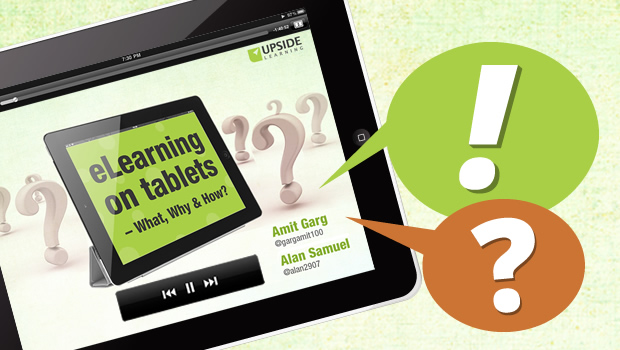Last week we conducted two very successful webinars – ‘eLearning on Tablets – What, Why & How?’. A big ‘thank you’ to those of you who could make it. We hope you found them informative and helpful. And for those of you who couldn’t, you can watch the recording – there’s a link a little further down.
While I tried to keep up with the questions and comments being fired at me during the webinars, there were some questions that went unanswered. So, for all those who were there, and for those who weren’t; here are all the questions and answers.
Embedded below is the recording of one of the webinars. It’s our take on ‘what’ is eLearning on tablets, ‘why’ you should be considering it and ‘how’ can you get started.
And now, here are the Q&As from the sessions. Hopefully they will answer some of your questions too! If you have any more questions that are keeping you up at night, drop me a line in the comment box below or email me at alan.ukinfo@upsidelearning.com
Q1: What is your status with Tin Can?
A: We have integrated Tin Can API into our proprietary courseware framework for custom eLearning and mobile learning. Using this framework we can develop Tin Can compliant courses for desktops, as well as mobile devices, including tablets. Read more.
Q2: I run an iPad loan scheme where I show how to use tablets in education. I recieved the iPads as part of an iPad in learning program. I have been focusing on Apple but wish to market other devices. Do you have a system that I can use where I add your tablet to my projects?
A: We don’t have our own tablets. But we do develop eLearning programs for a wide range of tablets (different OSs, makes, screen sizes etc.) as mEnablement or new development projects. More on our eLearning on tablet solutions here. We do, however, sell a mobile platform – Upside2Go – which is used to manage and deliver learning and performance support across devices.
Q3: Is the drive towards smaller (7″) tablets mostly due to cost or are there other (better) reasons?
A: While cost is possibly one of the key reasons, portability is probably the more pressing reason for smaller tablets. Connectivity is of course a given, but similar functionality (to larger tablets) in a light, easy –to-carry-and-use size would be a key driver.
Q4: Mentioning the stylus, in the school market, it is still a concern that kids need to learn how to write. Is stylus a feasible solution?
A: It is possibly part of a solution, depending on what the kids use the stylus for. E.g. Maths would be perfect, but perhaps not writing an essay. Like with a mouse, a stylus could also help in ‘hand-eye’ coordination tasks. E.g. learning games.
Q5: What is the process to put an HTML5 course onto a tablet (for freelancers who don’t have an IT department to work with)?
A: There are two ways you can put or view a course on a tablet:
I. While viewing it online: You can upload the course on FTP or any server or on an LMS if the course is SCORM, AICC or Tin Can compliant.
II. While viewing it offline: Download the course from the server or transfer the course on your tablet device using a data cable. If you are working with a Android tablet, you can directly access the downloaded files to view the course. For iOS devices, you need to have applications like GoodReader, FileBrowser or FileManager to view the course offline.
Q6: I am concerned more about setting it up for an iPad. Doesn’t MAC have a large set of standards for eLearning courses on their tablets?
A: On the contrary, the iPads are quite easy to design for. A simple HTML course authored using an authoring tool runs very neatly on the iPad too. Check out our list of 5 authoring tools for publishing courses on iPads.
Q7: Often, tablets are shared within organisations. This creates challenges in terms of security, consistent access to information or apps and making it an easy process to borrow the devices. What apps/software would you recommend to aid the management of a departmental set of devices?
A: It depends on your delivery system and your organization’s security standards. One of the simplest ways of dealing with shared devices is log in and password protection. Upside2Go, our mobile platform for performance support, allows you to manage your users like you would do on an LMS and once set up, users would have their own unique access which would allow them to use common devices without compromising data security or user confidentiality. In one of our presentations – eLearning on iPads – 10 Bright Ideas – we have listed some security measures for tablets.
Q8: Hi, would you recommend building a different course for learners using PCs and for those using tablets? In other words, would you recommend a different instructional approach whether the content is to be seen on a PC or a tablet?
A: If you are building exclusively for a tablet delivery then certainly a different approach would be advisable. This is mainly because the process of interaction on a tablet is quite different to that on a PC/ laptop (E.g. touch, double touch etc.). But you can build a multi device output quite successfully without a radical change in approach. One way is by using responsive web design. The key, however, is to use responsive, responsibly.
Q9: So, if we design for PCs and tablets, we should think mobile first. And if, we build for tablets exclusively, we should build for mobile exclusively. And you would recommend the same authoring tools for both devices?
A: In our opinion, eLearning on tablets is not quite the same as mobile learning. The main argument is – the context in which the two devices are used and the purpose for which the learning is being done makes all the difference. You can look at eLearning on tablets as a great starting point to move towards ‘real’ mLearning in the future. There are certain tools that claim to produce a responsive output. In such cases you could target both devices but the dependency on tools is very high. Some tools don’t have this option but they provide separate templates for tablets and mobiles. But this is not the best of solutions as you have different eLearning courses for tablets and mobiles. We recommend going with custom development if you are targeting different screen sizes with different pixel densities (PPI).
Q10: Is click and drag possible on tablets?
A: Yes.
Q11: What tool options are available to convert existing Flash content to HTML5?
Q: We have converted most of our Flash content to HTML5. But many remain to be converted.
A: You can still use a lot of the legacy assets but it’s probably best to do a combination of conversion and re-development. We have explained this in our presentation – mEnabling your eLearning. Some readily available tools that you can use to convert your existing Flash-based courseware to tablet compatible format are: Lectora Inspire, Flash CS6 Toolkit for CreateJS, Flash Professional CS5 to name a few. Check out other cost-effective solutions for converting eLearning to tablet learning.
Q12: Any data we have on the number of android devices to apple ones?
A: From what we hear and the stats say, Android has been Apple’s biggest competition, flooding the market with countless hardware designs and configurations to suit just about anyone’s needs or better yet, budget. However, iOS devices are “#1 in customer usage” with iPhone users clocking in approximately 50% more minutes of smartphone usage v/s Android users.
Q13: One major barrier for us in the Pacific is the Internet costs, and accessibility of it – slow speeds and expensive packages. While we are providing most of our contents that don’t require a connection but having one gives it more use. We preload content such as course materials and ship them off to students. For syncing, we use our Learning management system MOODLE but it is a problem cause of the design of the MOODLE Database.
A: Pre-loaded content is definitely a good solution but again, it’s not the best as it doesn’t account for frequent updates to the content. In which case, syncing becomes a necessity. One way to deal with syncing issues is to use our mobile learning platform for performance support – Upside2Go. Upside2Go has limited dependency on Internet/GPRS. This allows your learners to access learning material even in offline mode. Besides, its automatic and manual synchronization ensures that your learners receive updates in real-time.
Q14: Any standard for content to be viewed on all kind of these devices. How is HTML5 going on?
A: HTML is more used than HTML5 or a combination of the 2. Courseware can still be SCORM, AICC compatible when built in HTML, so there has been no shift in standards.
Q15: How about iPad access flash based contents?
A: Flash and the iPad aren’t very friendly! That said, there are workarounds and browsers that allow you to view Flash content on an iPad, but it’s not ideal and probably not sustainable either. You are better off moving to HTML – from a future proofing perspective too. In one of our earlier blog posts – Why Tablets Are A Game Changer – we had mentioned that many a HTML5 projects that we do is a result of organizations just playing safe and future proofing their solutions rather than for actual, immediate use.
Upcoming Events
Performance Support Symposium 2013 | Sep 09–11 | Boston, MA
CLO Summit India | Sep 12–13 | Mumbai, India


















